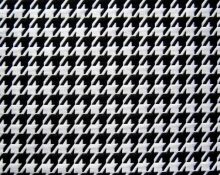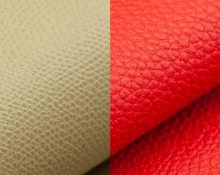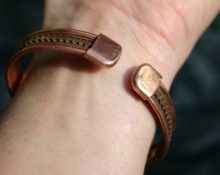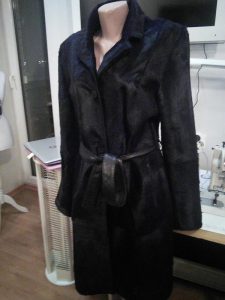
creativecommons.org
Winter is coming - and it’s time to choose fur coats, insulated coats and sheepskin coats. Every fashionista is familiar with products made from rabbit, sheep, fox, arctic fox and mink fur. But pony fur coats are still not so popular among our compatriots. Thanks to short pony fur, designers can experiment with colors and patterns, and women have the opportunity to purchase relatively budget-friendly new items and follow trends. In this material we will talk about pony fur and describe how to sew a coat from this material at home.
Pony fur: what kind it is
To create the materials, they use the fur of specially bred short-haired horses, whose wool will subsequently require the least processing by technologists. The skins of white Scottish ponies, Welsh black horses, “golden” Exmoor ponies, and spotted Shetland horses are widely used.Black pony fur is especially popular among furriers, as it is relatively inexpensive, looks impressive and does not require additional processing. Competent craftsmen achieve a special shine from the material, characteristic of products of the 1950s. Slightly more expensive two-color or three-color fur is also popular.
Pros and cons of pony fur
Over the past few years, pony fur products have become increasingly popular. Pony fur is often chosen by designers and beginning seamstresses, as it has a number of fundamentally important characteristics.
- Pony fur is relatively light. Compared to mink or fox fur, pony fur is lightweight, which makes clothing made from this material more comfortable. This factor can be a plus for mobile work, when the owner of a pony fur coat needs to look presentable, travel a lot or combine several jobs at once. With a busy schedule, heavy coats and fur coats made of “noble” furs often become uncomfortable, especially at the end of the working day, but a pony fur coat is perfect for an active business woman or car lady.
- Variety of textures and colors. Due to the relative cheapness of raw materials and susceptibility to coloring, designers can experiment with this type of fur and dye it in different colors. Thus, fashionistas can purchase budget coats made of pony fur, made to look like leopard or python.
- Pony fur is pleasant to the touch. Of course, this can be said about many types of fur, but unlike the usual long fur, pony hair is very short, and when processed it feels like velvet or plush to the touch.
- Elasticity of fur. Another point for which tailors love it: it is relatively easy to process. In fact, pony fur is comparable in flexibility and elasticity to ordinary fabric.Advanced craftsmen sew from this material not only fur coats, but any other clothes and even... underwear. But it must be emphasized that the latter are custom-made products. Usually, more trivial things are made from short pony fur: demi-season coats, skirts, trousers, winter shoes and bags.
But, even despite all the advantages of this material, pony fur also has some minor disadvantages.
- Pony fur is impractical. Unlike thick, heavy fur coats, pony fur coats are not designed for severe frosts. Rather, this is an option for the European winter.
- There are also reviews about the poor wear resistance of pony fur. But for the sake of fairness, it is worth noting that they relate mainly to the finishing of shoes.
What you need to sew a pony coat
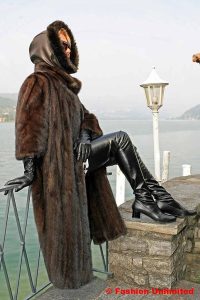
creativecommons.org
Sewing a coat from pony fur implies that you have already worked with this material. If this is your first fur product, we recommend starting with sewing a fur hat to get used to working with fur.
- A piece of pony fur in the color you want. Please note that if your choice is not plain fur, you will have to allow additional time for customizing the pattern and making adjustments.
- Optionally, to decorate the collar and sleeves, you can use pieces of other, fluffier fur to play on the contrast of volumes. Fluffy silver fox fur is often used for these purposes.
- Sewing accessories for processing fur (specialized needles, sharp scissors or a stationery knife, a special device for fixing fur (optional), patchwork pins or clothespins, etc.).
- Coat buttons. Alternatively, you can use hooks or even a zipper.
- Warping tape for strengthening seams and edges.
- Pattern adjusted to the required parameters.
Step-by-step plan for sewing a pony fur coat
The material will allow you to sew long and short coats from pony fur, so you can adjust the pattern to the length you need: make a long coat to the floor or shorten it as much as possible to the length of a demi-season jacket.
- Adjust the pattern to the size of the model.
- Secure the pattern to the material using pins. Please note that the product is cut with strict adherence to the direction of the pile. If you plan to work with leather a lot, it makes sense to purchase a so-called saddle, or quick clamp. It will help you grind the material by hand faster and serve as a third hand that fixes and pulls the fur.
- Cut out the parts from the wrong side, keeping an indentation of about 4 cm. Add 5-8 cm of indentation to the middle cut. Remember that fur products are cut strictly by weight.
- If this is your first job or you have doubts about the sizes, it is better to test the accuracy of the pattern by sewing a mock-up of a coat from linen fabric. If you don't want to spend money, you can use long patchwork pins or simple clothespins to securely secure the fur.
- Sew the coat pieces together. Please note that the seams are not too thick; first cut off the pile at the laid allowances. Even such a relatively thin material as pony fur will gather at the edges and seams if the wool is not pre-treated.
- Reinforce the seams and edges of the product with keeper tape.
- Sew buttons or hooks.
- If desired, you can decorate the sleeves and collar with fluffier fur for contrast.


 0
0